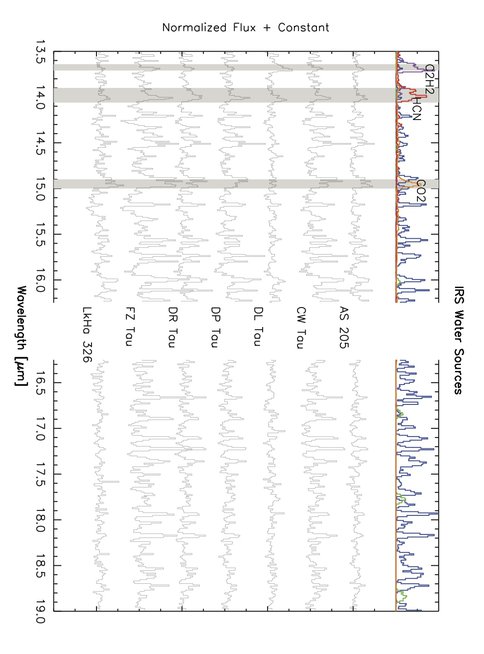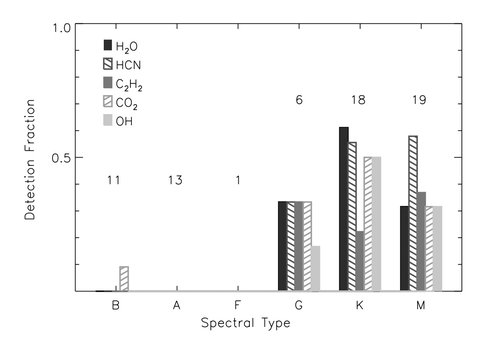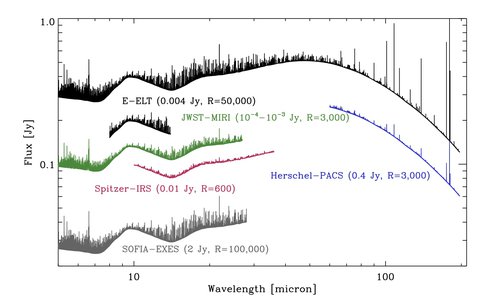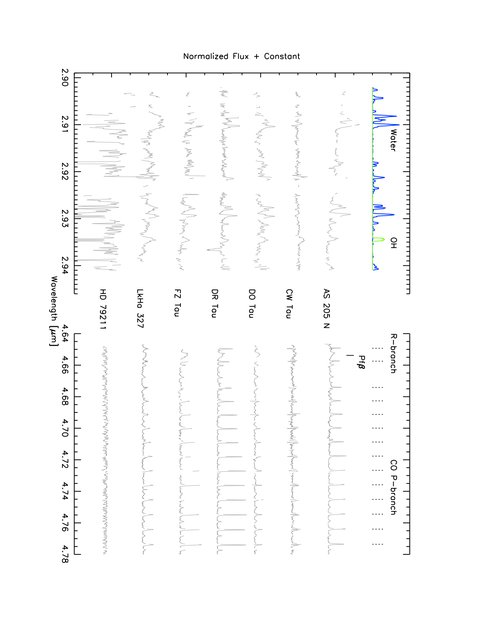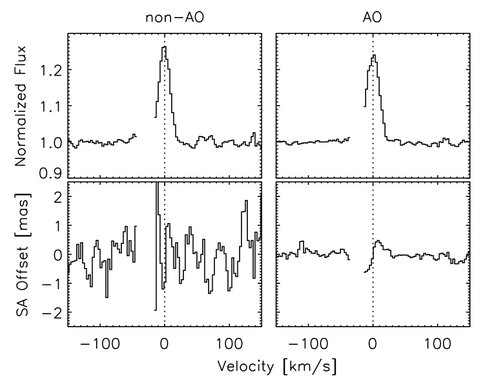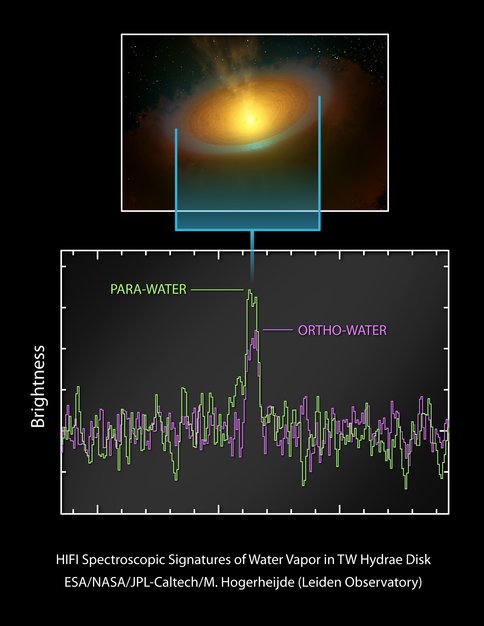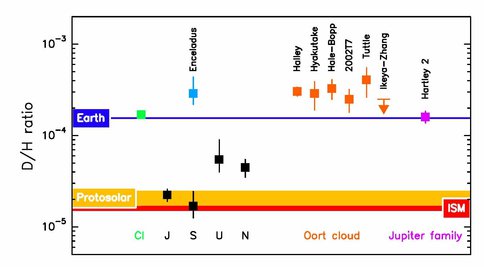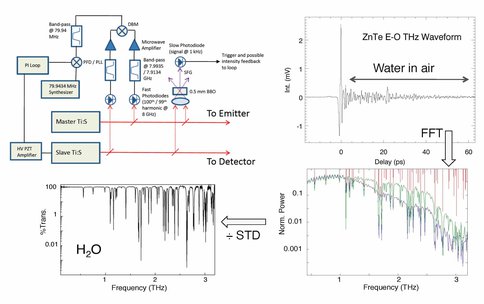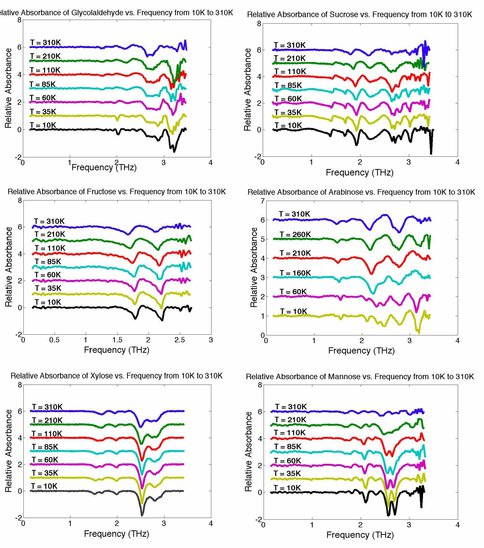2011 Annual Science Report
 NASA Goddard Space Flight Center
Reporting | SEP 2010 – AUG 2011
NASA Goddard Space Flight Center
Reporting | SEP 2010 – AUG 2011
Observations of the Water and Organic Content of Protoplanetary Disks and Comets
Project Summary
The Blake group has been carrying out joint observational and laboratory program with NAI node scientists on the water and simple organic chemistry in the protoplanetary disk analogs of the solar nebula and in comets. It has been a highly productive year. The major overview papers outlining the results from our extensive (>100 disks) Spitzer IRS survey of the molecular emission from the terrestrial planet forming region are now published, and the initial follow-up work with GSFC scientists on the high spectral resolution ground based observations of such emission has just been submitted for publication. We have probed the outer disk’s water emission with the Herschel HIFI instrument, and also measured the D/H ratio in a Jupiter Family Comet for the first time with Herschel – finding a value consistent with that in the Earth’s oceans. Now that ALMA is ramping up toward operations, we look forward to high angular resolution observations of simple organics in the outer regions of disks and comets over the coming years. The full suite of results will permit the first detailed examination of the radial water and gas phase organic chemistry in planet-forming environments.
Project Progress
1. Scienfitic Background: As part of the overall Astrobiology Node at the NASA Goddard Space Flight Center, whose goal is an understanding of the Origin and Evolution of Organics in Planetary Systems (Mike Mumma, P.I.), Co-Investigator Blake is directing both laboratory and astronomical spectroscopy programs. The goal of these observations is to determine whether complex organics are detectable in the circumstellar accretion disks that encircle young stars and in the comae of comets. By acting as conduits for mass and angular momentum transport, circumstellar disks provide the pivotal observational link between star formation and (exo)planetary science. The disk internal structure is particularly important for planet formation and evolution, but is difficult to image directly (Dullemond et al. 2006). Thanks to the strong temperature/density gradients in disks, volatile compounds will condense at different locations. For example, in the solar nebula the “snowline” (water ice) appeared near 3–5 AU, while CO frosts are only stable where Tdust ∼ 20 K.
Thus, the predictions are that the major disk molecules, at all radii, are H2 and CO; but that the gas phase abundances for other species are strong functions of radius and height. The major condensible, H2O, exerts a dominant influence on the carbon chemistry (Boonman et al. 2000), and is transported outward as vapor from the inner disk (Stevenson & Lunine 1988); icy bodies drift inward (Ciesla & Cuzzi 2006). The gas composition should thus be sensitive to disk transport processes. Further, rocky planets are largely stripped of water by accretional heat and (giant) impacts, and one of the key questions as to our origins is thus how water and other volatiles were transported from the outer solar nebula into the terrestrial planet-forming zone and eventually to the surface of the early Earth.
2. Observational Effort: Observations of water vapor and the simple but rather less abundant precursors to complex organics (HCN, C2H2 , CH4) in extrasolar planets, and in circumstellar disks undergoing planetary system formation, would be instrumental in testing the scenario outlined in §1. Both water and methane have now been seen in the extrasolar planet HD189733b (Swain etal. 2008); and while H2O has been detected in vast quantities in molecular clouds and protostellar envelopes (Boogert et al. 2004, Watson et al. 2007), there are only a handful of reported ice (Terada et al. 2007) and vapor (Shiba et al. 1993, Carr et al. 2004, Eisner 2007) spectra toward pre-main sequence stars.
We are therefore testing the expectations concerning the physico-chemical evolution of proto planetary disks through extensive high resolution IR and far-IR spectroscopic surveys of the molecular content of disks and comets. Our ongoing NIRSPEC M-band spectroscopic survey has confirmed that CO is indeed a widespread tracer in classical (Blake & Boogert2004) and transitional (Salyk et al. 2007, 2009) disks. Spectro-astrometric observations of the CO v=1→0 band (with CRIRES at the VLT) have confirmed the expected Keplerian velocity fields and “imaged” the disk gas down to scales of <0.1AUin many disks (Pontoppidan et al. 2008), but have also revealed unexpected non-Keplerian (radial velocity) signatures in a substantial suite of protoplanetary disks (Pontoppidan et al. 2011). As we show next, the combination of Spitzer-IRS and Keck/VLT/Gemini observations has been highly successful at detecting water vapor and volatile organics in the disks around classical T Tauri stars (cTTs). This critical step forward clearly holds the promise of more detailed studies involving statistically significant samples, which forms the basis of our observational research supported by the GSFC Astrobiology Node.
Spitzer/Keck/VLT Program: By pushing the dynamic range of the Spitzer-IRS to its limits as part of the “Cores to Disks” Legacy program (c2d, Evans etal. 2003) we were among the first to detect water vapor and organics from both nearly edge-on (via absorption, Lahuis et al. 2006) and inclined disks (via emission, Salyk et al. 2008, see also Carr & Najita 2008 and Furlan et al. 2006). The emission lines from water, CO2, HCN, and C2H2 are at the few percent line:continuum level, as shown in Figure 1. Toward the end of the cryogenic Spitzer mission we joined forces with J.Carr and J.Najita as part of a ∼60 hour Priority 1 Spitzer GO-5 medium program to capitalize on these developments and lay the foundation for studies of the physical and chemical state of the gas – the dominant reservoir of disk matter – at planet formation distances (PID#50641, J. Carr, P.I.).
Figure 1. The 13.5-19.0 μm portion of the Spitzer-IRS spectra of several Perseus/Taurus circumstellar disk sources obtained in the GO-5 program along with AS205N and DR Tau (Salyk et al. 2008). Atop the data LTE models of H2O, OH, CO2 , HCN, and C2H2 emission at ∼800 K are displayed. Broad features, such as the silicate 10 and 18 μm bands, have been removed with spline fits to the original data to highlight the molecular emission. The line:continuum excess of the strongest emitters (CW Tau, FZ Tau) is ∼ 10%.
At λ/Δλ=600, the water+organics emission lines suffer from severe line blending across the full SH+LH wavelength span. In Fig. 1 we present expanded versions of the data for several Taurus sources and AS205, along with LTE models(re-sampled toR=600). Because well defined predictions of disk chemistry versus perturbations in evolutionary state are not (yet) available, the IRS GO-5 program deliberately spanned a range in disk settling, accretion rate, and X-ray luminosity. The first two quantities may serve as rough indicators of evolutionary “age,” and the full GO-5 cTTs sample covered a much larger range in each of the chosen disk characteristics than have been examined to date. To this data set we have added archival spectra from the c2d and GTO programs to examine the molecular content of disk surfaces as a function of stellar type (mass). Interestingly, we have found that the majority of cTTs disks display water and simple organic emission lines, while the spectra of Herbig Ae stars and transitional disks display little/no emission across the Spitzer passband (see Figure 3) – but are strong emitters in the CO Δ =1 bands near 4.7 μm. Over the past year we have completed our (first order) analysis of these data and presented our findings in two significant Ap. J. manuscripts (Pontoppidan et al. 2010a, Salyk et al. 2011).
Figure 2. The Spitzer detection rate as a function of spectral type for the strongest infrared molecular tracers, with the number of each spectral type shown above.
Figure 3. A full range calculation of the IR water spectrum from a typical protoplanetary disk. In addition, scaled (for clarity) model spectra convolved to the spectral resolution of various observatories are shown, along with their rough sensitivities (10σ/1 hr) and spectral resolving powers.
At the Spitzer IRS resolution the origin of the emission can only be crudely estimated, and so high spectral resolution follow-up observations are essential to measure the line profiles and thus determine the emitting radius (Salyk et al. 2008,Mandell et al. 2008). We have recently developed highly efficient statistical equilibrium radiative transfer models of disks that can be used to simulate the full spectral energy distribution at high spectral and spatial resolution (Pontoppidan et al. 2009), and present in Figure 3 a simulated SED/spectrum for the AA Tau disk. Nearly all of the GO-5 targets are too faint for direct 10-20 μm ground-based spectroscopic studies, even with 10m-class telescopes, but we have managed to detect 12 μm water emission lines from two of the brightest disks in Ophiuchus with VLT-VISIR (Pontoppidan et al. 2010b), and recent observations with Gemini-MICHELLE (January 2011) have provided additional detections in four disks in Taurus. Thankfully, as Fig. 4 shows NIRSPEC L-band R=25,000 set ups can also detect and resolve H2O/OH lines in disks. Indeed, while the atmosphere blocks most of the strong water lines from the ground, there remain numerous higher excitation transitions that can be observed from warm disk gas (R∼1AU). Longer wavelength orders (3.0-3.4 μm) provide access to the C–H stretch mode of organics such as HCN/C2H2 and CH4 (not shown in Fig. 4). As described below, we are working with Dr. Avi Mandell on high precision atmospheric fitting routines that enable nearly shot noise-limited L-band observations, and we have submitted our first publication on the ~3 μm detection or organics in disks (Mandell et al. 2012).
Since the water and CO line profiles are quite similar at the velocity resolution of NIRSPEC, we use combined fits to estimate the water/OH emission temperature and column density (from the weakest lines), inner emitting radii(0.5-1AU), and emitting area(from CO, see Fig. 4). Provided the system is not oriented face-on, kinematics can be extracted out to ∼10-20 AU, and the water line profiles should be sensitive to the location of the “snow line” (Meijerinket al. 2009). With all of the GO-5 data in hand, the HCN and C2H2 abundances appear to be significantly enhanced in the inner disk (Salyk et al. 2011, see also Lahuis et al. 2006, Carr & Najita 2008), and significantly correlated with the water abundance. To further answer questions questions concerning disk transport mechanisms, dust processing, and disk evaporation (Acke et al. 2005,Alexander et al. 2006),the radial and vertical distribution of the water vapor, OH, and simple organics must be determined. Accordingly, we are using support from the Astrobiology program to complete the L-band survey that concentrates on the GO-5 Spitzer-IRS sources. The Keck/NIRSPEC echelle is being used for sources in Perseus and Taurus, VLT/CRIRES for sources in Ophiuchus and Chameleon.
Figure 4. Current NIRSPEC L-band data for several of the GO-5 IRS program sources, illustrating that high quality spectra can be obtained under clear conditions (left column). LTE models of water and OH emission are again placed at the top as a guide to the eye. (Right column) NIRSPEC M-band spectra of these same sources, showing the intense CO Δv=1 emission widely observable from disks. The Pf β transition is also marked. Spectra of the M0V main sequence dwarf HD 79211 are included at bottom to illustrate the nature of photospheric contributions at these wavelengths.
These (natural seeing) data are now largely in hand, and so we have also begun to investigate the spectro-astrometric capabilities of NIRSPEC at L- and M-band – now possible thanks to filter and pupil stop revisions to this instrument. Although the raw counts/sec drops by a factor of ∼ten compared to natural seeing-limited NIRSPEC data, and even with some seventeen warm mirrors between the instrument and sky, the M-band source/sky emission line contrast is markedly improved in NIRSPEC-AO mode thanks to the cold pupil stop and smaller solid angle of sky imaged by each pixel. Importantly, the drop in background is sufficient to enable multiple reads of the detector, which substantially offsets the drop in throughput. The longer integration times also drop the number of co-adds, which lowers the fixed pattern (read) noise. Nodding along the slit is quite accurate (to within1-2 pixels once the loops are closed), and over the course of three nights in Decemer 2010 with seeing variations from 0.”5 to >2” the Strehl ratio remained remarkably consistent.
To generate spectra, curvature in the 2D echellograms is first removed and an accurate wavelength scale derived from the numerous sky lines. Then, Spectro-Astrometry (SA) signatures are obtained by measuring the centroid of the emission versus wavelength. A comparison of the spectra and SA signatures acquired in NIRSPEC-AO (14Dec2010, 19 min. of integration) and NIRSEPC (17 Dec 2010, 18 min. of integration) modes at comparable airmasses and natural seeing of <0.”7 are shown in Figure 5. To remove atmospheric and instrumental artifacts, SA signatures are best obtained by paired spectra with a selected slit PA and PA±180°. In natural seeing, constant PA mode, the NIRSPEC image rotator is found to introduce significant and time variable background at M band that precludes SA observations for all but a select range of PAs. The AO image rotator showed no such structure over the three nights. From the data presented in Figure 5, we measure a dynamic range on the continuum(for velocity windows of ±40-150 km/s) of 188 in the AO-mode, and 121 for non-AO mode observations. Over the same velocity range, the standard deviation for the SA signal is 140 μas for AO observations, and 760 μas for the non-AO data. Similar results are found at L-band. Importantly, the cross dispersed nature of NIRSPEC enables many more lines of water and OH to be obtained as compared to CRIRES, and for simultaneous observations of water and organics. As such, future SA observations with NIRSPEC are presently our highest observational priority.
Figure 5. Comparison of NIRSPEC CO M-band spectra from the transitional disk LkHα 330 (top) along with the Spectro-Astrometric (SA) signature in natural seeing(left) and NGS mode (right). Seven CO lines are stacked to produce the spectra (Salyk et al. 2009), and regions with <70% atmospheric transmission are masked. To process the SA data (see Pontoppidan et al. 2008 for a detailed description of SA observing procedures and data analysis), spectra were acquired at slit position angles (PAs) of 165° and 345°. The Keplerian signature from gas in the inner regions of the disk is clearly detected in the AO observations.
For the very brightest targets, extremely high dynamic range observations are needed, and for this purpose we are continuing our collaborative work with the Mumma group on the analysis of high SNR data with routines developed at NASA GSFC. The application of these routines to the first detection of the OH radical in the disk saround Herbig Ae stars is described in Mandell et al. (2008), and substantially improves the quality of the data obtained for T Tauri stars (such as those presented in Fig. 4). Successive observations have already revealed the presence of HCN and, perhaps, NH3 in L-band spectra of cTTs, and these codes should also have applications to the high SNR spectroscopy of extrasolar planetary transits and secondary eclipses. A first dataset/analysis on HD 189733b has been published (Mandell etal. 2011), and Dr. Mandell is presently hard at work on the data reduction for Keck observations of the transits of the super-Earth GJ 1214b, which must take extraordinary care of potential systematic artifacts in the data. If successful, such R=25,000 spectra of extrasolar planet atmospheres will be of great interest to other NAI teams.
Herschel Program: The near-to mid-IR program outlined above is not sensitive to water or OH in the outer regions of circumstellar disks where comets are likely to form, nor can they be used to search for more complex organics such as those seen in carbonaceous chondrites. Two major instruments, the Herschel Space Telescope and the Stratospheric Observatory For Infrared Astronomy, are poised to change this situation dramatically by undertaking the first detailed exploration of the far-IR sky. Prof. Blake is a member of the HEXOS and WISH Key Program Guaranteed Time teams as well as the DIGIT Key Program Open Time team, and with former Hubble Fellow Dr. K. Pontoppidan (P.I.) has anOT-1program centered on very deep integrations with PACS on a suite of cTTs with strong Spitzer molecular emission. With these data, we will characterize the water and OH far-IR emission lines from disks. In combination with the IR data either in hand or to be obtained with NAI support, the Herschel data will precisely locate the “snow line” in the disks around T Tauri stars.
The broad wavelength coverage of Herschel will also permit a much improved understanding of ices in disks, and thus the origin of icy bodies such as comets. Ices are notoriously difficult to detect in circumstellar disks via their otherwise strong mid-IR resonances, simply because any material warm enough to excite these resonances will not retain volatiles. Thus, the SEDs of most disks are dominated by emission from refractory dust grains. Only for a few systems with very favorable, inclined, geometries have ices been seen, and for these systems the potential ice detections disks are difficult to interpret. Herschel will offer the unique chance to observe ices in disks in emission through a number of far-IR resonances, which are excited at temperatures low enough for dust grains to retain their volatile component. These include the known 62 μm lattice mode of water ice, the 85/150 μm features of solid CO2 and the 89 μm feature of CH3OH. All data reduction expenses will be covered by Herschel funds, here we are using the NAI support to, again, collaborate with the Mumma group on the global interpretation of the ice data and how it relates to the measurements of volatiles in comets. After a bit of a shaky start, the HIFI instrument is now back on-line, and so we are now receiving HIFI+PACS spectral scans of circumstellar disks in both the DIGIT and OT-1 programs.
Because the organics in the inner regions of disks are so closely tied to water, we are also using the HIFI instrument on Herschel to search for gas phase water signatures in the outer regions of disks and in comets, to great effect. In the disk around TW Hya we have detected the ground state ortho and para lines of water for the first time in such objects (Hogerheijde et al. 2011), and we have also made the first measurements of the D/H ratio in water from a Jupiter family comet, specifically Comet 103P Hartley 2 that was the subject of the EPOXI flyby and that we have worked with the Mumma group on infrared observations using Keck in support of the EPOXI and Herschel campaigns. Interestingly, we find that the D/H ratio in Hartley is substantially lower than that in Oort cloud comets, and the same as that in the Earth’s oceans (Hartogh et al. 2011). This substantially enlarges the region of the solar nebula with a “terrestrial” isotopic composition, and highlights the great uncertainties associated with the formation region of comets and the dynamical evolution of the early solar system. Figures 6 and 7 present overviews of this work, that appeared in Science and Nature over the last month. For NASA press releases on this work, see http://www.jpl.nasa.gov/news/news.cfm?release=2011-327 (TW Hya) and http://www.jpl.nasa.gov/news/news.cfm?release=2011-312 (Hartley 2), respectively.
Figure 6. Herschel HIFI detection the emission from cold water vapor in the planet-forming disk around the young star TW Hydrae. The vapor arises from a vast reservoir of icy grains, which interacts with ultraviolet light from the central star, as depicted in the artist’s rendering of the TW Hya disk at the top of the figure. Both the ortho and para forms of water, in which the two spins of the hydrogen nuclei have different orientations, are seen; and the ratio of ortho to para water seen in the TW Hydrae disk is very low compared to that in comets. Lower ratios indicate cooler temperatures, though in practice the analysis is much more complicated. This is the first demonstration that water exists in large quantities in the frigid, outer regions of solar systems, where comets take shape. Apadted from Hogerheijde et al. (2011).
Figure 7A & 7B. Herschel HIFI detections of the H218O and HDO rotational line emission from Comet 103P Hartley 2. The velocity scale is given relative to the nucleus velocity. (Right) D/H ratios in the Solar System. The orange squares show values measured for water in several Oort-cloud, while the arrow for 153P/Ikeya-Zhang indicates an upper limit. The HIFI data on the Jupiter-family comet 103P/Hartley 2 is shown by a purple square. Black symbols pertain to the D/H ratio in H2 in the atmosphere of the giant planets—Jupiter, Saturn, Uranus and Neptune. D/H values for water in the plume of Saturn’s moon Enceladus and in CI carbonaceous chondrites are displayed with green and light blue symbols, respectively. Error bars are 1σ. The D/H determinations in comets originating from the Oort-cloud are twice the value for the Earth’s ocean (shown by the blue line) and a factor of about ten larger than the protosolar value in H2 (shown by the broad yellow line), the latter being comparable to the value in atomic hydrogen found in the local interstellar-medium (ISM, red horizontal line). The D/H ratio in the Jupiter-family comet 103P/Hartley 2 is the same as the Earth’s ocean value and the mean chondritic CI value. Uranus and Neptune have been enriched in deuterium by the mixing of their atmospheres with D-rich protoplanetary ices. Adapted from Hartogh et al. (2011).
Figure 7B.
3. Proposed Lab Work: The other area we remain active in with NAI support is in the laboratory study of the far-IR modes of complex organics. Searches for the rotational transitions of large molecules using even the most capable new facilities such as the GBT and, soon, ALMA are becoming increasingly constrained by spectral line confusion where it is the overlapping emission from the many molecules present and not instrument performance that limits the search “sensitivity.” Thankfully, Herschel now offers (as will SOFIA) dramatically new opportunities for the discovery of complex extraterrestrial organics through searches for the lowest frequency torsional or bending vibrations of molecules. With such modes both polar and non-polar species maybe examined, in either the gas phase or in the solid state, just as in the mid-IR. Furthermore, the spectral line confusion should be eased by the “spreading out” of the low energy vibrations, and complete rotational resolution for systems in excess of 30 atoms in size should be readily possible (at least in the lab).
For organics some 20-25 atoms in size with gas phase abundances 10-12 that of H2, the expected band/continuum ratio for high mass protostars is several percent. In addition to the previously outlined programs, the “HEXOS: Herschel Observations of EXtra-Ordinary Sources: The Orion and Sgr B2 Star-Forming Regions” (E. Bergin, P.I.) KP GT surveys will reach much deeper than this over the full HIFI and PACS ranges. The achieved RMS demonstrates the expected fall off in the pure rotational envelope of small-to-moderate sized gas phase species (Crockett et al. 2010), meaning that sensitive searches for more complex species (amino acids, sugars, etc.) are now possible. Thus, there is every expectation that new discoveries can be made. Nearly nothing is known about these modes, however, and so they must be measured in the laboratory first. The challenging nature of far-IR studies should not be underestimated, however, since the generality and uniqueness to molecular structure associated with such low energy torsions/vibrations comes at a price. These dynamically complex modes are extremely difficult to predict theoretically, and so the search space is very large (unlike that at microwave frequencies).
With NSF support we have recently constructed a TeraHertz Time Domain Spectrometer, or THz TDS. With this instrument (for a layout see Figure 8) we now have complete coverage of the spectral ranges accessible to Herschel/SOFIA at a dynamic range of >106 and without any need for cryogens. We can therefore now rapidly assess the possibility of detecting complex organics with Herschel. The range of possible compounds to be studied is vast, and the selection of initial targets is being done in consultation with the cosmochemists and geochemists of the NASA GSFC NAI node. We are first examining the THz TDS spectra of simple solid state films or aqueous solutions, including cryogenic measurements, and by this winter (2011) plan to move onto studies of the most promising systems in the gas phase, after we have relocated the laboratories into the newly renovated Linde+Robinson laboratory on the Caltech campus. The necessary sample cells and cold head are operational in Prof. Blake’s laboratory. Initial data on sugars, taken by Caltech Summer Undergraduate Research Fellowship recipients Mr. Kevin Sutherland and Ms. Kristen Hoeltz, are shown in Figure 9. Similar data are available on a similar suite of amino acids and on nearly 100 naturally occurring silicate and carbonate samples (done in collaboration with Prof. George Rossman’s group in GPS at Caltech). As can be seen, the structure of the THz signatures are sensitive to temperature; and so if eventually detected can provide not only species identification but a characterization of the physical state of the molecular ices on interstellar or protostellar grains as well.
Figure 8. An overview of the asynchronous optical sampling time domain THz spectrometer (top left). The stabilization scheme results in jitter below 100 fs, and absolute frequency calibration to better than a part in 1012. At top right the time domain signature acquired with this instrument in ∼20 seconds is displayed. The “ringing” after the main pulse is due to atmospheric water vapor, as is shown in the power spectrum produced by an FFT of the time domain data at lower right. When divided by a purged background scan, very high SNR spectra can be acquired in seconds with a resolution of ∼100 MHz and no moving parts.
Figure 9. THz time domain spectra of glycoaldehyde, sucrose, fructose, arabinose, xylose, and mannose, in pressed powder pellets mixed with polyethylene, measured in the frequency range from 0.3 to 3.5 THz and over temperatures from 310 to 10 K. Spectra have been offset for clarity.
References: Acke, B., van den Ancker, M.E., & Dullemond, C.P. 2005, A&A, 436, 209
Alexander, R.D., Clarke, C.J., & Pringle, J.E. 2006, MNRAS, 369, 229
Blake G.A. & Boogert, A.C.A. 2004, ApJ, 606, L73 Boogert, A.C.A. et al. 2004, ApJS, 154, 359
Boonman, A.M.S. et al. 2000, ApJ, 553, L63
Carr, J.S. et al. 2004, ApJ, 603, 213; Carr, J.S. & Najita, J. 2008, Science, 319, 1504
Ciesla, F.J., & Cuzzi, J.N. 2006, Icarus, 181, 178
Crockett,N.R.,Bergin,E.A.Wang,S. et al. 2010(63 authors),A&A521,L21
Dullemond, C.P. et al. 2006, Protostars & Planets V, 555
Eisner, J.A. 2007, Nature, 447, 562
Evans, N.J. et al. 2003, PASP, 115, 965
Furlan, E. et al. 2006, ApJS, 165, 568
Hartogh, P. et al. (12 co-authors) 2011, Nature, 478, 7367
Hogerheijde, M. et al. (14 co-authors) 2011, Science, 334, 338
Klatt, G., Gebs, R., Janke, C., Dekorsy, T., & Bartels, A. 2009, Optics Express, 17, 22847
Lahuis, F. et al. 2006, ApJ, 626, L145
Mandell, A. et al. 2008, ApJ, 681, L25
Mandell, A., Deming, D., Blake, G.A., Knutson, H., & Mumma, M. 2011, ApJ, 728, A18
Mandell, A., Bast, J., van Dishoeck, E.F., Blake, G.A., Salyk, C., Mumma, M.J., & Villanueva, G.
2012, ApJ, submitted
Meijerink, R., Pontoppidan, K.M., Blake, G.A. et al. 2009, ApJ, 704, 1471
Pontoppidan, K. et al. 2008,ApJ,684,1323(AO-fed spectro-astrometry w/VLT-CRIRES)
Pontoppidan, K., Meijerink, R., Dullemond, C.P. & Blake, G.A. 2009, ApJ, 704, 1482
Pontoppidan, K.M., Salyk, C., Blake, G.A., Meijerink, R., Carr, J. & Najita, J. 2010a, ApJ,
720, 887
Pontoppidan, K.M., Blake, G.A., Salyk, C. & Kaufl, H. 2010b, ApJ, 722, L173
Pontoppidan, K.M., Blake, G.A. & Smette, A. 2011, ApJ, 733, 84
Salyk, C., Blake, G.A. et al. 2007, ApJ, 655, L105; ibid 2009, ApJ, 699, 330
Salyk, C., Pontoppidan, K., Blake, G.A. et al. 2008, ApJ, 676, L49
Salyk, C., Pontoppidan, K.M., Blake, G.A., Carr, J. & Najita, J. 2011, ApJ, 731, 130
Shiba, H., Sato, S., Yamashita, T., Kobayashi, Y., & Takami, H. 1993, ApJS, 89, 299
Stevenson, D.J. & Lunine, J.I. 1988, Icarus, 75, 146 Swain, M.R., Vasisht, G., & Tinetti, G. 2008, Nature, 452, 329
Terada, H. et al. 2007, ApJ, 667, 303
Watson, D.M. et al. 2007, Nature, 448, 1026
Publications
-
Braakman, R., Belloche, A., Blake, G. A., & Menten, K. M. (2010). SEARCH FOR INTERSTELLAR METHOXYACETONITRILE AND CYANOETHANOL: INSIGHTS INTO COUPLING OF CYANO- TO METHANOL AND AMMONIA CHEMISTRY. The Astrophysical Journal, 724(2), 994–1005. doi:10.1088/0004-637x/724/2/994
-
Hartogh, P., Lis, D. C., Bockelée-Morvan, D., De Val-Borro, M., Biver, N., Küppers, M., … Blake, G. A. (2011). Ocean-like water in the Jupiter-family comet 103P/Hartley 2. Nature, 478(7368), 218–220. doi:10.1038/nature10519
-
Hogerheijde, M. R., Bergin, E. A., Brinch, C., Cleeves, L. I., Fogel, J. K. J., Blake, G. A., … Van Dishoeck, E. F. (2011). Detection of the Water Reservoir in a Forming Planetary System. Science, 334(6054), 338–340. doi:10.1126/science.1208931
-
Mandell, A. M., Deming, L. D., Blake, G. A., Knutson, H. A., Mumma, M. J., Villanueva, G. L., & Salyk, C. (2011). NON-DETECTION OFL-BAND LINE EMISSION FROM THE EXOPLANET HD189733b. The Astrophysical Journal, 728(1), 18. doi:10.1088/0004-637x/728/1/18
-
Mumma, M. J., Bonev, B. P., Villanueva, G. L., Paganini, L., DiSanti, M. A., Gibb, E. L., … Magee-Sauer, K. (2011). TEMPORAL AND SPATIAL ASPECTS OF GAS RELEASE DURING THE 2010 APPARITION OF COMET 103P/HARTLEY 2. The Astrophysical Journal, 734(1), L7. doi:10.1088/2041-8205/734/1/l7
-
Salyk, C., Pontoppidan, K. M., Blake, G. A., Najita, J. R., & Carr, J. S. (2011). A SPITZER SURVEY OF MID-INFRARED MOLECULAR EMISSION FROM PROTOPLANETARY DISKS. II. CORRELATIONS AND LOCAL THERMAL EQUILIBRIUM MODELS. The Astrophysical Journal, 731(2), 130. doi:10.1088/0004-637x/731/2/130
-
Villanueva, G. L., Mumma, M. J., DiSanti, M. A., Bonev, B. P., Gibb, E. L., Magee-Sauer, K., … Salyk, C. (2011). The molecular composition of Comet C/2007 W1 (Boattini): Evidence of a peculiar outgassing and a rich chemistry. Icarus, 216(1), 227–240. doi:10.1016/j.icarus.2011.08.024
-
PROJECT INVESTIGATORS:
-
RELATED OBJECTIVES:
Objective 1.1
Formation and evolution of habitable planets.
Objective 1.2
Indirect and direct astronomical observations of extrasolar habitable planets.
Objective 3.1
Sources of prebiotic materials and catalysts
